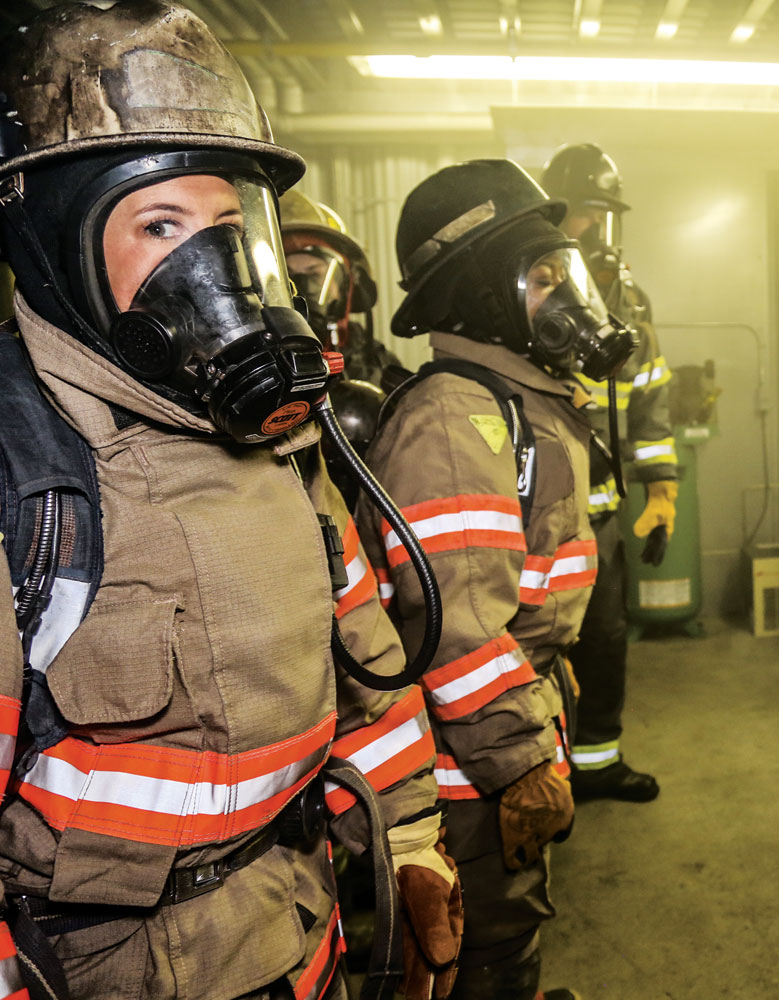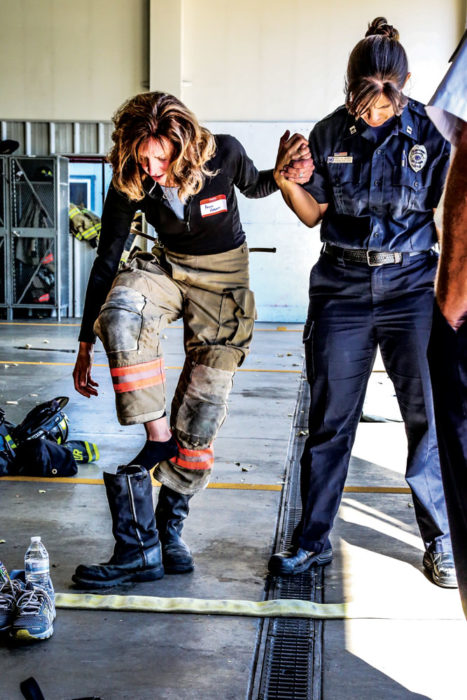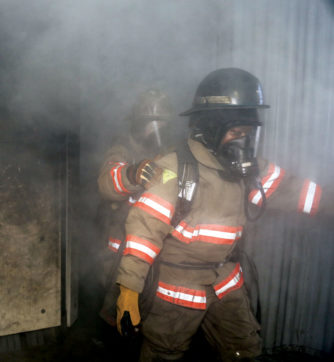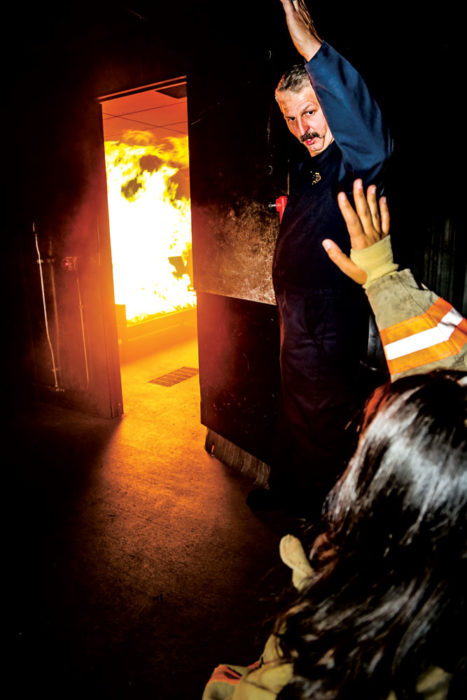
Fire protective gear provides coverage from head to toe.
I am covered from head to toe in heavy protective layers. There is a disconcerting feeling of sensory deprivation and it takes several minutes before I feel comfortable.
Suited up, I quickly discover that wearing 60 lbs. of protective clothing and gear makes climbing stairs and negotiating smoke-filled spaces a big challenge. Firefighters practice to achieve the “muscle memory” required to don their gear in less than a minute.
In this media training session about fire investigations, we make our way to the state-of-the-art training facility. Firefighters come from across the country to train at this tower near 55th and Quebec since it realistically simulates many of the conditions they will encounter on the job. We enter a space so filled with black smoke it is impossible to see six inches ahead. The breathing mask provides fresh air—but each tank lasts for only 45 minutes.
Experiencing the heat of an actual burn is intense. Fire gear protects against heat generated by flames, but it also retains body heat. We’re instructed to drink plenty of water to stay hydrated.
After climbing six flights of stairs, encountering smoke and flames, I remove my helmet and mask. Never has cool, fresh air felt so good.
DFD Burn House 3 from Anne Hebert on Vimeo.

The author suits up in 60 lbs. of firefighter’s protective clothing.
Fire investigators begin work when the fire is extinguished and fire suppression efforts are still underway, and they maintain their presence at the scene to document and collect evidence, says investigator Scott Renter. The process is often painstaking and requires sifting through the debris left behind after a fire. They determine how heat, fuel and oxidation contributed to the fire in order to establish the cause. Based on what they learn, investigators classify fires into one of four categories: accidental, incendiary, natural or undetermined.

The smoke got so thick that visibility was only about six inches.
Beginning on the outside of the building, they survey the exterior damage to establish where the fire may have started. Telltale clues such as burned grass or debris may indicate that a fire began outside and spread to the structure. Absence of fire damage outside indicates the fire began inside. Witnesses are interviewed and may help corroborate or contradict a specific theory. “Investigators often wear street clothes because it puts the people we need to talk to at ease and makes getting important information a much less stressful process,” says Renter. “People often respond differently to an individual in uniform.”
Not heard at fire investigations is the word arson. Arson may be associated with incendiary or undetermined events, but it is not a category used to define the cause of a fire. A straightforward explanation for a fire usually exists.
Firefighters have three priorities: life safety, incident stabilization and property conservation. To do their jobs effectively, they work in cohesive units. “Life in a firehouse is like living with a second family,” says Captain Carly Helwick, a third-generation firefighter who is married to a firefighter. “You might wonder why firefighters grocery shop together as a group,” Helwick says. “It’s because doing these normal errands together reinforces our connection. In this way, we strengthen our bonds and know our partners almost as well as we know ourselves.” By shopping, dining and living together while on duty, firefighters learn each other’s behaviors and this translates into enhanced safety in risky situations. Taylor emphasizes, “By knowing how your fellow firefighters might react, you’re better able to watch out for and protect each other on the job. Firefighters are a family and we take our responsibilities to each other extremely seriously.”

A firefighter demonstrates the difference in heat intensity from floor to ceiling.
Firefighters respond to all emergency calls except those reported as a crime in progress. For that reason, the public may have interactions with firefighters in many situations that don’t involve a fire. All firefighters are EMT certified upon graduation. They respond to emergency calls on roadways, at businesses and private residences, and often provide immediate medical attention to those who require it. Emergency dispatchers receive 382 emergency calls in each 24-hour shift to which firefighters respond.
Fire Facts
- Three out of five home fire deaths occur in homes without working smoke alarms
- 450 people are killed from accidental carbon monoxide poisoning yearly
- Smoke alarms need to be replaced every 10 years; Carbon monoxide alarms every 5 – 10 years. Denver Fire Dept. has a limited number of 10-year battery smoke alarms that signal when they need to be replaced. These batteries are also available at a 20% discount through Nov. 30 at www.firstalertstore.com/DenverDiscount—enter discount code, DenverFD.




0 Comments